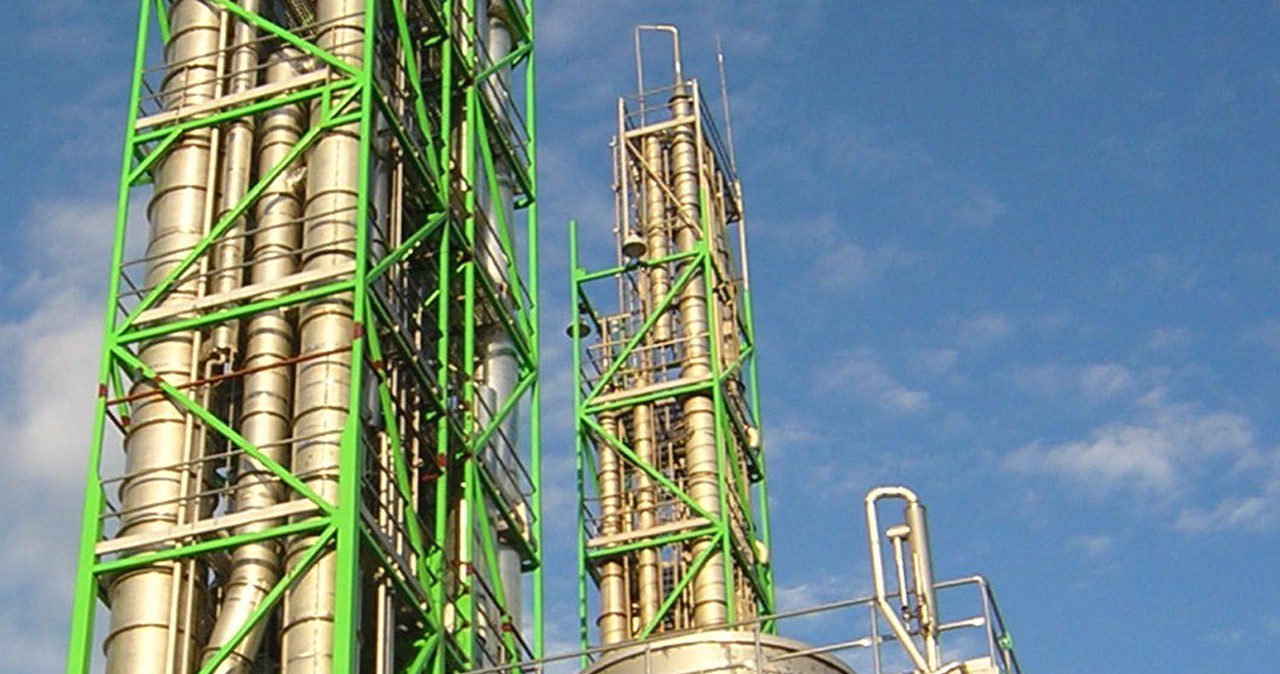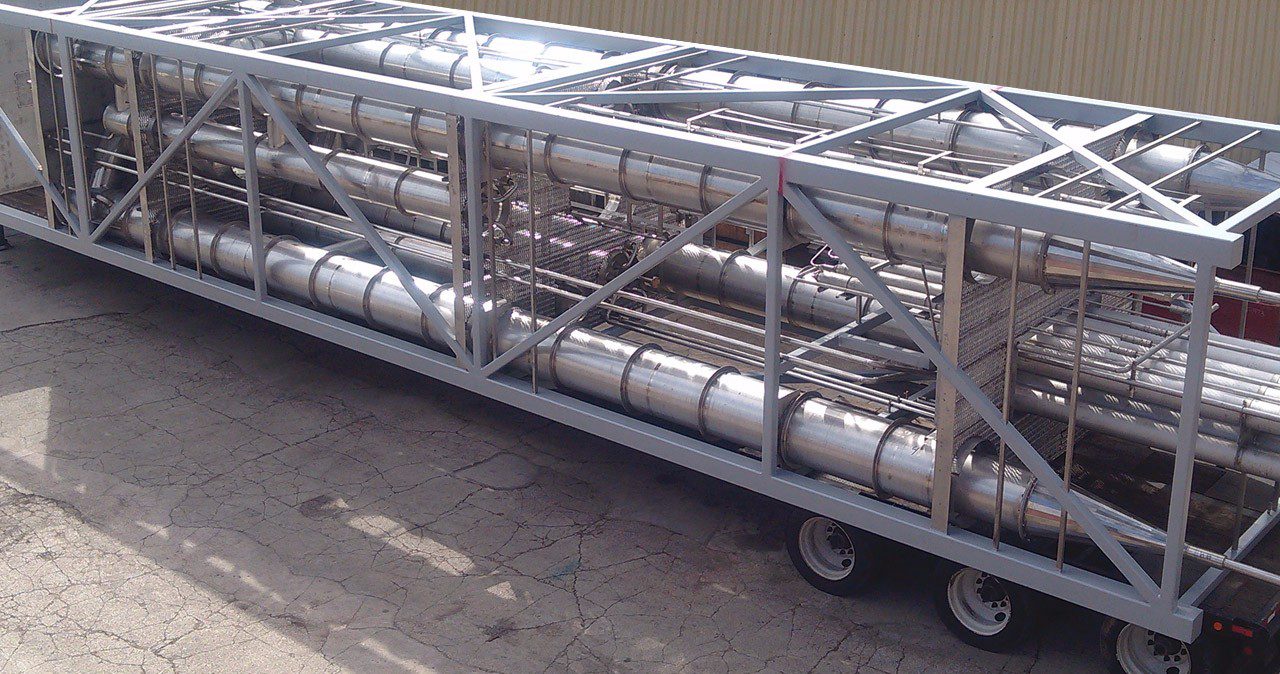- A steady juice feed with steady Brix and viscosity. (steady amount of pulp wash).
- A steady tank level, not stopping and starting.
- A good juice, not fermented or with too much pulp.
- A steady steam supply, consistent and adequate pressure. (Not up and down).
- Steady barometric water supply, consistent temperature and volume. Not too cold or too hot.
- Not much back up in flash cooler level.
- No rain, no electrical disruptions, and not to much fiddling with the controls.
- No air leaks, or mechanical breakdowns.
JUICE EVAPORATORS, PRINCIPLES OF OPERATION AND TROUBLESHOOTING
November 29, 2004 by 1 Comment
HISTORY
Commercial evaporation of orange juice began in the late 1940’s. The first evaporators, to
produce a product to be reconstituted and used as orange juice, were low temperature-high
vacuum evaporators designed and built by B.C. Skinner of Dunedin, Florida. There were several
evaporators built on this basis (Frostproof, Auburndale, Dunedin).
As operational experience was gained, it became standard practice to pasteurize the juice before
packing (usually in cans). By the 1950’s pasteurization became common. This is still true as
commercial operation experience has shown it is necessary to pasteurize orange juice. (While a
“roadside” operation may be successful with unpasteurized juice, anything more substantial is
always on the edge of failure.) With pasteurization came a high temperature evaporator.
TASTE evaporators
The first TASTE evaporator was designed and built by Ralph Cook in 1960 as a improved high
temperature evaporator. The TASTE evaporator produced a stable concentrate with little heat
damage. By the mid 1960’s TASTE evaporators were the standard evaporator in Florida.
Other evaporators have been tried, plate evaporators (low quality juice and expensive
maintenance), and low temperature evaporators such as freeze concentration and reverse
osmosisus (stability problems in storage and expensive operation).
Why is the TASTE evaporator an improved design? Short temperature exposures. Simple
operation. No recirculation. Low delta T’s (less chance for burn on). Better air removal. Preheating of juice and
better juice distribution.
Principle of operation of TASTE evaporators
TASTE evaporators are designed to produce quality juice concentrates at a minimum operating
cost. These evaporators operate on the principle of high temperature, short time exposure and
thermally accelerated descending flow. Flow patterns and other design features may be changes
to suit the particular application.
Description:
The TASTE evaporator is a single pass with multiple effects and stages. The number of effects
are normally four to seven. The number of stages are normally six to eight.
Juice flow:
The juice at ambient temperature is fed to the evaporator through feed tanks (a balance tank
should be able to hold thirty minutes of juice supply). The standard flow pattern is a “mixed”
flow pattern. Juice enters the evaporator and travels through interstage preheaters and essence
condensers. The juice goes to the first stage which is at an intermediate temperature this provides
a very efficient deaeration and aroma stripping. The juice stabilizer (pasteurizer) is prior to the
hottest stage which is usually the second or third stage. As the juice is pumped into any of the
stages, it will pass through a nozzle (or nozzles).At this point the incoming juice will flash into
the distribution section. This flash causes a sudden expansion of the feed, thus atomizing the
liquid, this fog like mixture of vapor and atomized liquid fills the distribution area and enters the
tubes in the stage body. The mixture accelerates downward through the tubes as it absorbs heat
from the tube walls. Because heating is at a constant pressure (within a particular stage) the
evaporation takes place at a constant temperature. As the juice evaporates the velocity of the
mixture in the tubes increases.
Some stages are composed of more than one tube bundle. This allows for fewer or smaller tubes
and therefore higher velocities at the beginning of the stage (reduced chance of juice sticking or
burning to the tubes).
The juice and evaporated water vapor exit the tube nest at the bottom. The vapor enters a cyclone
type liquid-vapor separator where the vapor is separated from any entrained product. The juice is
then transferred by pump or by gravity to the next stage. Each stage is similar in that the juices
enters the top through a nozzle (or nozzles), flashes, is accelerated downward as a turbulent flow
through the tubes until the evaporated vapor is separated from the entrained juice in the separator.
Each of the effects does approximately the same amount of evaporation, that is for a five effect
evaporator each effect will do approximately 20% of the total water removal. When the juice is
transferred to a higher temperature effect, the juice passes through a preheater to raise its
temperature as required to obtain the flash into the next stage.
After passing through all stages the concentrate goes ( by gravity or by pumping) into the flash
cooler. The flash cooler is a vacuum flash chamber. The concentrate flashes, raising its Brix
about 2°and lowering its temperature to approximately 55°F.
Vapor flow
Steam enters the shell side of the last preheater and the first effect. This steam is normally at
atmospheric, but can be slightly pressured 5 psi. For special applications the evaporator can be
designed for vacuum steam.
The vapor from the first effect evaporation is at a lower pressure than the heating steam. This
vapor is used to heat the second effect. The second effect at a still lower pressure is used to heat
the third effect. And so on until the last effect. The vapor from the last effect is condensed in the
barometric condenser (or an evaporative condenser).
Steam Condensate
The steam condensate exits the first effect at the bottom of the stage. This is normally returned to
the boiler feed water tank. The vent for the first effect is usually just above the steam condensate
drain. If steam is blowing out of this vent, then there is too much steam.
Vapor condensate
Vapor condensate from the second effect is flashed through an orifice into the third effect, and
combined second and third effect vapor condensate is flashed into the fourth effect. And so on
until the last effect. The combined condensate from the last effect may pass through a condensate
stripper to remove aroma compounds present in the water. This condensate is pumped out of the
evaporator for disposal or reuse.
Venting
A large vent from the second effect is usually used for the collection of essence. This first “boil
off” is the best quality and highest in concentration of essence components. The third effect vent
is also often included in the essence collection system. In general the vent from each effect may
go through a vent condenser or an essence condenser then to the air removal system (vacuum
system) to discharge to atmosphere.
Barometric condenser/ Evaporative Condenser
The barometric condenser operates at about 28 inches of vacuum. This vacuum is created and
maintained by air removal jets which discharge the air and other noncondensables. The last effect
vapor and the vapor exhaust from the cooling booster are condensed by direct contact with
barometric water. The water supply to the barometric should be a steady and consistent flow. The
flow is adjusted with a normal throttling valve. The tail leg water temperature is generally 100° to
105° F.
Most new T.A.S.T.E. evaporators have evaporative condensers instead of barometric condenser.
In the evaporative condenser the cooling water drips on the outside of the condenser tubes. The
last effect vapor is condensed inside the tubes. The cooling water is recirculated. The fan
provides the air movement to keep the water cool. When an evaporative condenser is employed
no cooling tower is needed.
Operating procedure
There are two primary operating adjustments on a TASTE evaporator.
The first is the juice flow rate. This is adjusted by changing the feed valve position or by
changing the speed of the pump with a variable speed control. The juice flow rate is the capacity
adjustment.
The second adjustment is the steam flow rate. This is changed the amount the steam valve is
open.
Sometimes this is called a pressure adjustment, as such there is an instrument to modulated the
steam valve in order to maintain the pressure setting. And sometimes this is called a temperature
control, where there is an instrument to modulated the steam valve to maintain the temperature set
point.
The juice flow through the evaporator takes 10 to 15 minutes. To change the Brix by adjusting
the juice flow rate is a slow process (and after the change, the Brix may initially go in the opposite
of the desired direction).
Changing the temperature gives a fairly quick response due to the short vapor transfer times. This
means temperature control should give a better Brix control.
Note, the pressure setting is a rather corse adjustment and probably does not give the desired fine
tuning necessary for a good adjustment of the Brix.
General operation
The best performance is accomplished under steady conditions.




What kind of damage does it do to your evaporator to leave your hogging jet on?